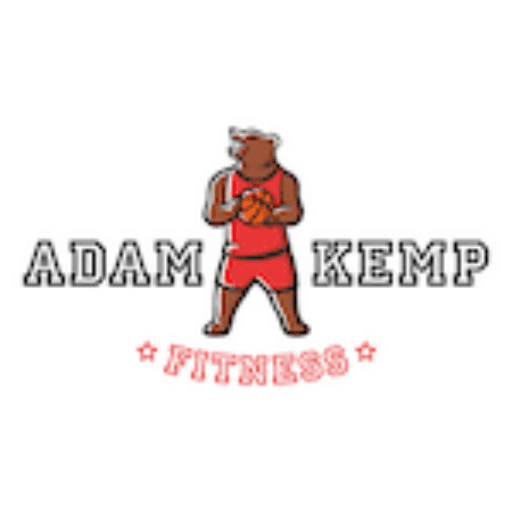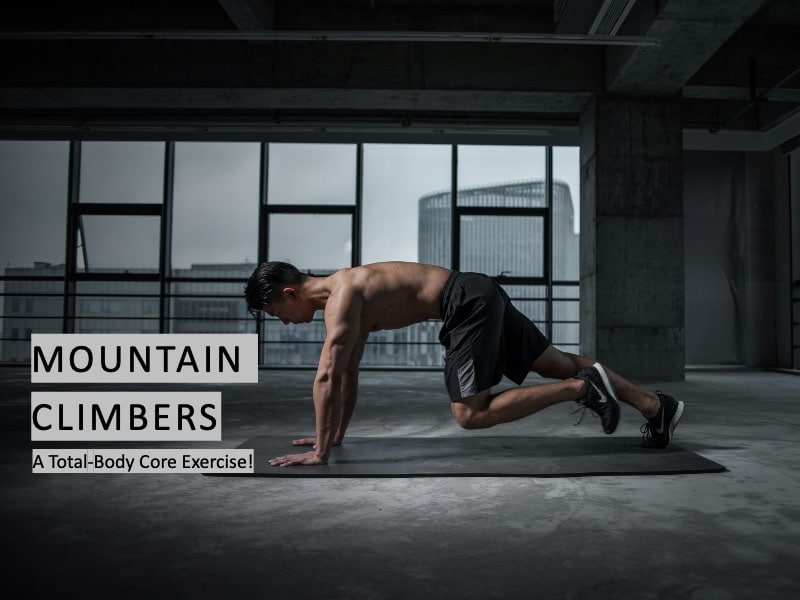Mountain Climber Exercise: Benefits, Muscles Used, How to Do
Mountain climbers are one of my favorite core exercises because they seamlessly combine core strength, abdominal endurance, and shoulder stability, which is a trifecta that has been essential for my performance on the basketball court.
The mountain climber exercise isn’t just about getting your heart pumping; it’s about building functional strength in a way that carries over into sports and daily life.
This is especially important for me because mountain climbers help strengthen and stabilize my shoulder, which took a hit in college when I tore my posterior labrum.
That injury taught me the value of exercises that promote both stability and mobility, and mountain climbers fit this need perfectly.
In addition, I’ve always considered mountain climbers one of the best alternatives to crunches for people who want to get six-pack abs because this exercise helps burn calories, build abdominal definition, and achieve an overall aesthetic body.
Whether you’re looking to build foundational strength as a beginner or intensify your training as an advanced athlete, mountain climbers offer a versatile, high-impact movement that doesn’t require equipment but still challenges the entire body.
The mountain climber exercise’s focus on core engagement, shoulder stability, and lower-body mobility is what makes it so effective and is the reason why it has become a staple for so many people.
What is the Mountain Climber Exercise?
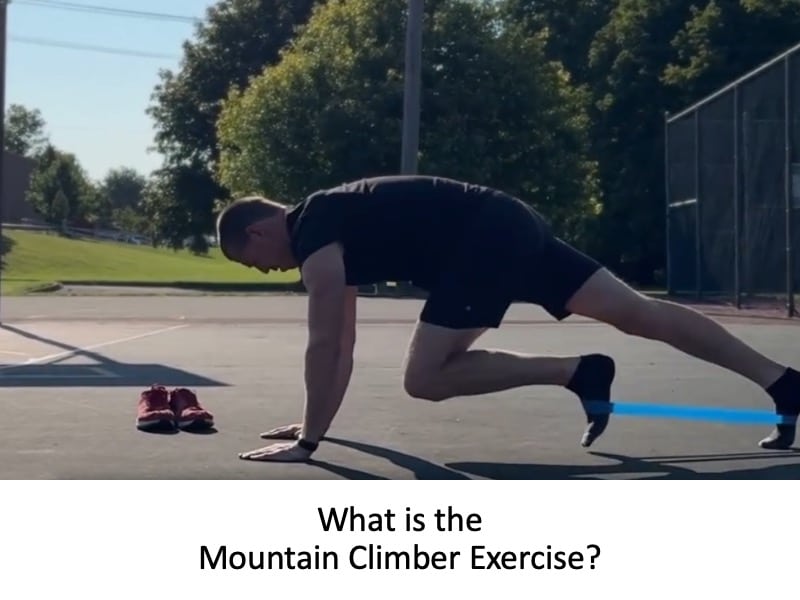
The mountain climber is a dynamic, bodyweight exercise that mimics the movement of sprinting in a horizontal position.
It combines elements of core stabilization, cardiovascular conditioning, and total-body strength, making it one of the most efficient functional movements you can do anywhere—no equipment required.
Mountain climbers start in a high plank position and drive the knees toward the chest in an alternating, rapid rhythm.
This continuous motion elevates the heart rate while simultaneously targeting multiple muscle groups, including the abdominals, shoulders, hip flexors, and legs.
The movement pattern is particularly effective for developing three pillars of athletic performance and general physical fitness:
- Core Endurance
- Shoulder Stability
- Aerobic Capacity
Because of its hybrid nature, the mountain climber exercise fits perfectly into HIIT routines, core circuits, or as a warm-up for strength or mobility sessions.
For athletes like myself, mountain climbers are more than just a metabolic booster.
They reinforce joint integrity and neuromuscular control, especially in areas prone to injury like the shoulders and hips.
I’ve relied on them throughout my career to bridge strength with coordination and stability, which are foundations that translate directly to sports performance and daily function.
How to Do the Mountain Climber Exercise
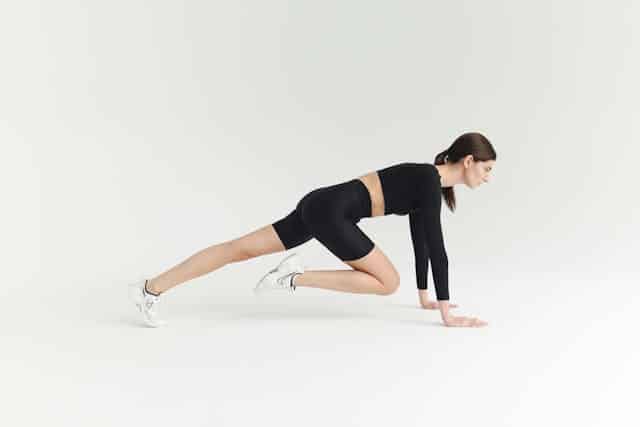
Mastering the mountain climber exercise helps you get the most out of its core-strengthening and cardio-boosting benefits.
Whether you’re new to fitness or a seasoned athlete, following the correct technique will help you avoid injury and maximize results.
Here is how to do the mountain climber exercise:
- Start in a Plank Position: Begin by placing your hands shoulder-width apart on the ground, directly below your shoulders. Extend your legs behind you so that your body forms a straight line from your head to your heels. Engage your core to maintain a flat back.
- Drive One Knee Toward Your Chest: Lift your right foot off the ground and drive your knee toward your chest, keeping your back flat and your hips level. Avoid allowing your lower back to sag or arch.
- Switch Legs: Quickly switch legs by extending your right leg back to the starting position and bringing your left knee toward your chest in a similar motion.
- Maintain Rhythm and Control: Continue alternating legs in a smooth, controlled motion while keeping your core engaged. Aim to increase speed as you become more comfortable with the movement, but always prioritize proper form.
- Breathing: Breathe steadily throughout the exercise. Exhale as you drive each knee toward your chest and inhale as you extend the leg back.
Muscles Worked by the Mountain Climber Exercise
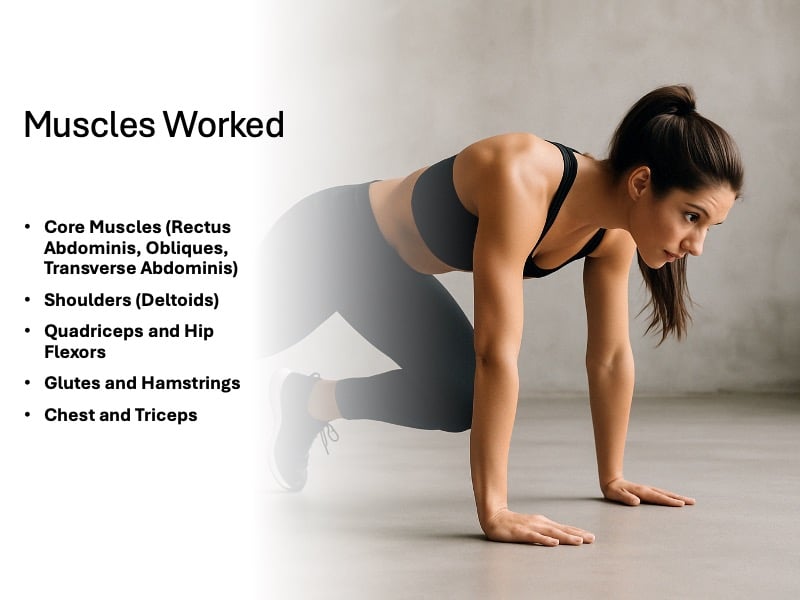
Mountain climbers are a compound movement that targets several muscle groups simultaneously, offering a full-body workout that improves both strength and coordination.
This functional movement mimics real-life activities that require coordination between upper and lower body muscles, making mountain climbers an effective exercise for improving muscular coordination, agility, and balance.
The primary muscles worked during the mountain climber exercise include:
Core Muscles (Rectus Abdominis, Obliques, Transverse Abdominis)
The core is heavily engaged throughout the mountain climber exercise, stabilizing the torso and preventing excess movement during each leg drive. This engagement improves core stability, enhancing balance and posture.
Shoulders (Deltoids)
The shoulder muscles are responsible for stabilizing the upper body while the legs are moving.
This continuous activation helps build shoulder endurance and strength, which is crucial for upper body stability.
Quadriceps and Hip Flexors
As the legs drive forward in alternating motions, the quadriceps and hip flexors work to pull the knees toward the chest. This repetitive movement helps develop lower-body endurance and flexibility.
Glutes and Hamstrings
The back of the legs, including the glutes and hamstrings, are activated as the legs extend back into a plank position. This helps improve the overall power and stability of the lower body.
Chest and Triceps
While maintaining a plank position, the chest and triceps support bodyweight, adding to upper body strength development.
Benefits of the Mountain Climber Exercise
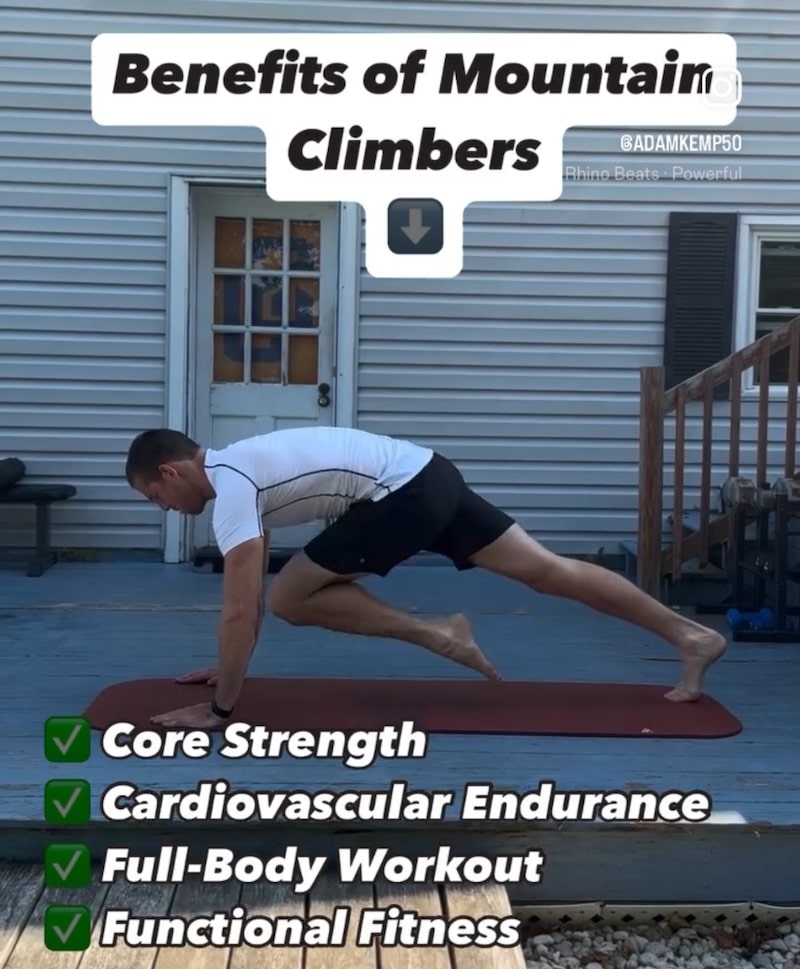
Mountain climbers are a versatile and effective exercise for building core strength, cardiovascular endurance, and overall functional fitness.
With options for beginners and advanced athletes alike, this exercise can be easily incorporated into any workout routine to help achieve a wide range of fitness goals.
Whether you’re looking to improve mobility, build muscle, or enhance endurance, mountain climbers are an excellent choice.
Improved Cardiovascular Conditioning
Mountain climbers rapidly elevate your heart rate due to their high-tempo, full-body movement, making them an efficient form of cardiovascular conditioning.
Research shows that bodyweight exercises performed in a high-intensity interval format significantly improve VO₂ max and support fat loss, making mountain climbers a valuable tool for heart health and metabolic conditioning (Martinez et al., 2015).
This makes them ideal for individuals looking to burn calories and improve cardiorespiratory endurance without needing access to a gym or equipment.
Better Core Stability and Strength
Maintaining a plank while alternating leg drives demands continuous engagement from the deep core muscles, including the transverse abdominis and obliques.
This anti-rotational core work improves spinal stability and has been linked to better balance and injury resilience, especially in sports and functional tasks (Kibler et al., 2006).
Over time, this helps improve postural control and reduces stress on the lower back during daily activities or other training movements.
Full-Body Strength Development
Mountain climbers activate multiple major muscle groups simultaneously—shoulders, chest, triceps, core, hip flexors, glutes, and quads, creating a compound movement that builds muscular endurance and functional strength.
This full-body engagement improves movement economy and helps reinforce neuromuscular coordination across kinetic chains.
Because of this total-body activation, mountain climbers are a great choice for those short on time but looking for a highly effective workout.
Increased Mobility and Flexibility
The repetitive knee drives dynamically mobilize the hips while engaging the lower abdominals and hip flexors, which can improve joint range of motion and muscular flexibility over time.
Dynamic stretching movements like these have been shown to increase flexibility and performance when integrated into regular training sessions (Behm & Chaouachi, 2011).
This makes the mountain climber exercise a valuable addition to dynamic warm-up routines or recovery-focused workouts for athletes and fitness enthusiasts alike.
Functional Movement Training
Mountain climbers train your body to work as an integrated unit, mimicking real-world movement patterns like running, climbing, or crawling.
These compound, multi-joint actions enhance proprioception, joint stability, and movement efficiency, which are qualities essential for both athletic performance and injury prevention in daily life (Myer et al., 2006).
Because they replicate natural movements, the mountain climber exercise helps improve agility, coordination, and balance across a wide range of sports and everyday activities.
Safety Tips and Common Mistakes
Although mountain climbers are a relatively straightforward exercise, improper form can lead to discomfort or injury. Keep the following safety tips in mind:
- Maintain Proper Plank Form: One of the most common mistakes is letting the hips sag or rise too high during the exercise. This can put strain on your lower back and reduce the effectiveness of the exercise. Keep your body in a straight line from head to heels throughout the movement.
- Avoid Over-rotating the Hips: Excessive twisting of the hips can lead to improper alignment, particularly for the lower back and shoulders. Focus on engaging your core to keep your hips stable and level.
- Don’t Lock Out the Elbows: Keeping your arms too rigid can place unnecessary strain on your shoulder joints. Maintain a slight bend in your elbows to protect your joints and allow for better shock absorption.
- Progress Gradually: If you’re new to mountain climbers, start slowly and increase the speed of the movement as your strength and coordination improve. Trying to go too fast too soon can compromise your form and lead to injury.
For those with existing knee or lower back issues, it may be beneficial to start with a modified version to reduce impact and build strength gradually.
Progressions and Regressions for the Mountain Climber Exercise
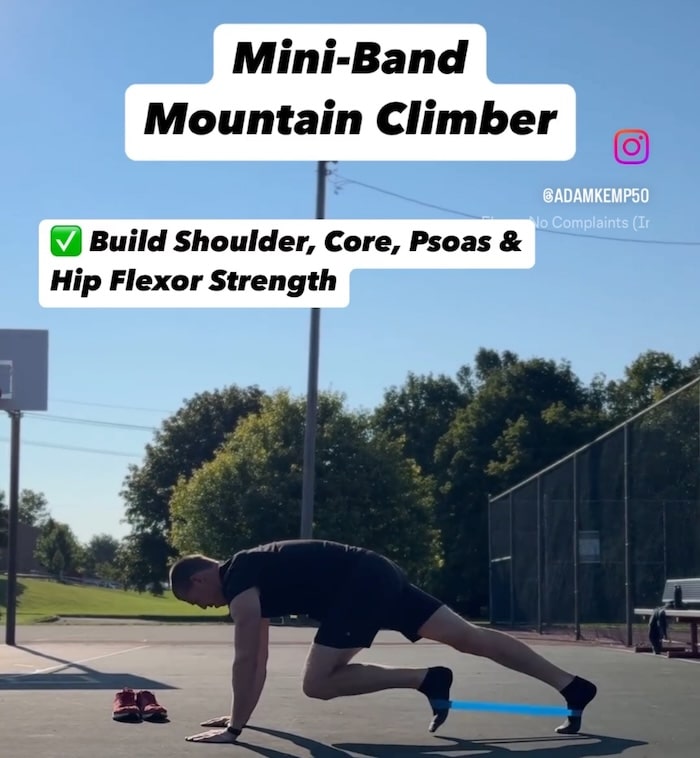
The mountain climber exercise can be easily modified to suit your fitness level, making them accessible to beginners and challenging for advanced athletes.
Beginner-Friendly Modifications
- Slow Mountain Climbers: Instead of driving your knees quickly, perform the movement slowly, focusing on engaging your core and maintaining control. This reduces the intensity while still working the necessary muscles.
- Incline Mountain Climbers: Place your hands on a raised surface, such as a bench or step, to decrease the load on your upper body. This reduces the difficulty and impact, making it easier for those new to the exercise.
Advanced Variations
- Cross-Body Mountain Climbers: Drive your knee toward the opposite elbow instead of straight toward your chest. This adds a rotational component, engaging the obliques more and increasing the intensity.
- Spiderman Mountain Climbers: As you drive your knee forward, bring it to the outside of your elbow to increase the activation of your hip flexors and core muscles. This variation also enhances mobility in the hips.
- Mini Band Mountain Climbers: For an added challenge, place a mini resistance band around your feet or just above your knees. The band adds extra resistance as you drive your knees toward your chest, increasing the workload on your hip flexors, glutes, and core. This variation also helps to improve lower body strength and stability while intensifying the cardiovascular aspect of the exercise. Focus on maintaining proper form and avoiding excess tension in the lower back by engaging your core throughout the movement.
Final Thoughts: Are Mountain Climbers a Good Exercise?
The mountain climber exercise is of the most effective bodyweight exercises for developing functional strength, improving core stability, and boosting cardiovascular endurance, all in a single movement.
Whether you’re a beginner building foundational fitness or an advanced athlete seeking efficient conditioning, mountain climbers offer a scalable, high-impact workout that translates to real-world performance.
Their ability to strengthen multiple muscle groups, enhance mobility, and burn calories makes them a smart choice for nearly any training goal.
With no equipment required and endless variations available, mountain climbers remain a staple exercise for anyone serious about health and fitness.
Frequently Asked Questions
Read Next: Toes to Bar Exercise Guide
This website does not provide medical advice. This website site does contain affiliate links, and purchases may earn a commission.
Read my Medical Disclaimer, Review Disclaimer, and Publishing Policies for more details. Use of this site indicates acceptance of these terms.
